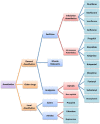Systemic immune effects of anesthetics and their intracellular targets in tumors
- PMID: 35966857
- PMCID: PMC9365985
- DOI: 10.3389/fmed.2022.810189
Systemic immune effects of anesthetics and their intracellular targets in tumors
Abstract
According to the result released by the World Health Organization (WHO), non-communicable diseases have occupied four of the top 10 current causes for death in the world. Cancer is one of the significant factors that trigger complications and deaths; more than 80% cancer patients require surgical or palliative treatment. In this case, anesthetic treatment is indispensable. Since cancer is a heterogeneous disease, various types of interventions can activate oncogenes or mutate tumor suppressor genes. More and more researchers believe that anesthetics have a certain effect on the long-term recurrence and metastasis of tumors, but it is still controversial whether they promote or inhibit the progression of cancer. On this basis, a series of retrospective or prospective randomized clinical trials have been conducted, but it seems to be difficult to reach a conclusion within 5 years or longer. This article focuses on the effects of anesthetic drugs on immune function and cancer and reviews their latest targets on the tumor cells, in order to provide a theoretical basis for optimizing the selection of anesthetic drugs, exploring therapeutic targets, and improving the prognosis of cancer patients.
Keywords: immune effect; intravenous; local anesthetics; opioids; tumor-associated signal pathway; tumor-targeting gene; volatile anesthetics.
Copyright © 2022 Luan, Li, Sun, Xu, Wang, Wang and Li.
Conflict of interest statement
The authors declare that the research was conducted in the absence of any commercial or financial relationships that could be construed as a potential conflict of interest.
Figures
Similar articles
-
Anesthetic and Analgesic Influence on Cancer Recurrence and Metastasis.AANA J. 2021 Jun;89(3):221-226. AANA J. 2021. PMID: 34042573
-
The effects of anesthetics on tumor progression.Int J Physiol Pathophysiol Pharmacol. 2013;5(1):1-10. Epub 2013 Mar 8. Int J Physiol Pathophysiol Pharmacol. 2013. PMID: 23525301 Free PMC article.
-
Effects of anesthetics on development of gynecological cancer.Front Cell Dev Biol. 2025 Apr 16;13:1587548. doi: 10.3389/fcell.2025.1587548. eCollection 2025. Front Cell Dev Biol. 2025. PMID: 40309242 Free PMC article. Review.
-
Can anesthetic-analgesic technique during primary cancer surgery affect recurrence or metastasis?Can J Anaesth. 2016 Feb;63(2):184-92. doi: 10.1007/s12630-015-0523-8. Can J Anaesth. 2016. PMID: 26497721 Review.
-
Effects of surgery and anesthetic choice on immunosuppression and cancer recurrence.J Transl Med. 2018 Jan 18;16(1):8. doi: 10.1186/s12967-018-1389-7. J Transl Med. 2018. PMID: 29347949 Free PMC article. Review.
Cited by
-
Suppressive effects of deep balanced anesthesia on cellular immunity and protein expression: a randomized-controlled pilot study.BMC Anesthesiol. 2025 Mar 17;25(1):129. doi: 10.1186/s12871-025-02980-9. BMC Anesthesiol. 2025. PMID: 40097954 Free PMC article. Clinical Trial.
-
Bibliometric Analysis of Anesthetic Drugs' Effects on Immune Function- Current Knowledge, Hotspots and Future Perspectives.Drug Des Devel Ther. 2023 Oct 26;17:3219-3230. doi: 10.2147/DDDT.S433629. eCollection 2023. Drug Des Devel Ther. 2023. PMID: 37908313 Free PMC article.
-
The effect of general versus spinal anesthesia on perioperative innate immune function in patients undergoing total hip arthroplasty.BMC Anesthesiol. 2025 Jan 7;25(1):10. doi: 10.1186/s12871-024-02883-1. BMC Anesthesiol. 2025. PMID: 39773137 Free PMC article.
-
Influence of Anesthetic Techniques on Colorectal Cancer Recurrence: A Comprehensive Review.Cureus. 2024 Aug 9;16(8):e66521. doi: 10.7759/cureus.66521. eCollection 2024 Aug. Cureus. 2024. PMID: 39252733 Free PMC article. Review.
-
The Immune Response in Two Models of Traumatic Injury of the Immature Brain.Cells. 2024 Sep 26;13(19):1612. doi: 10.3390/cells13191612. Cells. 2024. PMID: 39404376 Free PMC article.
References
-
- Aminoff MJ, Daroff RB. Encyclopedia of the Neurological Sciences. Waltham, MA: Academic Press; (2014).
-
- Schüttler J, Schwilden H. Modern Anesthetics. Berlin: Springer; (2008). 10.1007/978-3-540-74806-9 - DOI
Publication types
LinkOut - more resources
Full Text Sources



